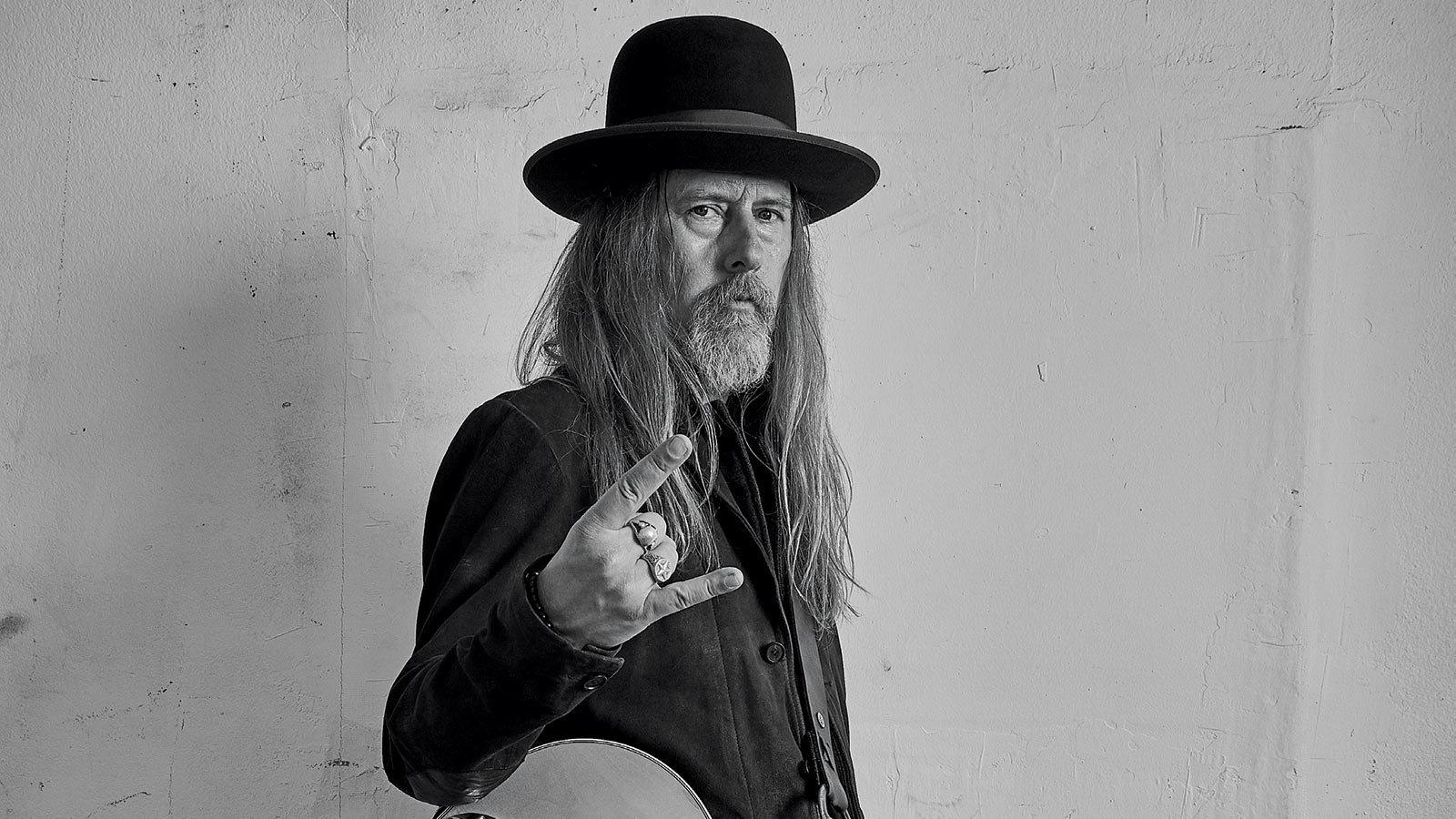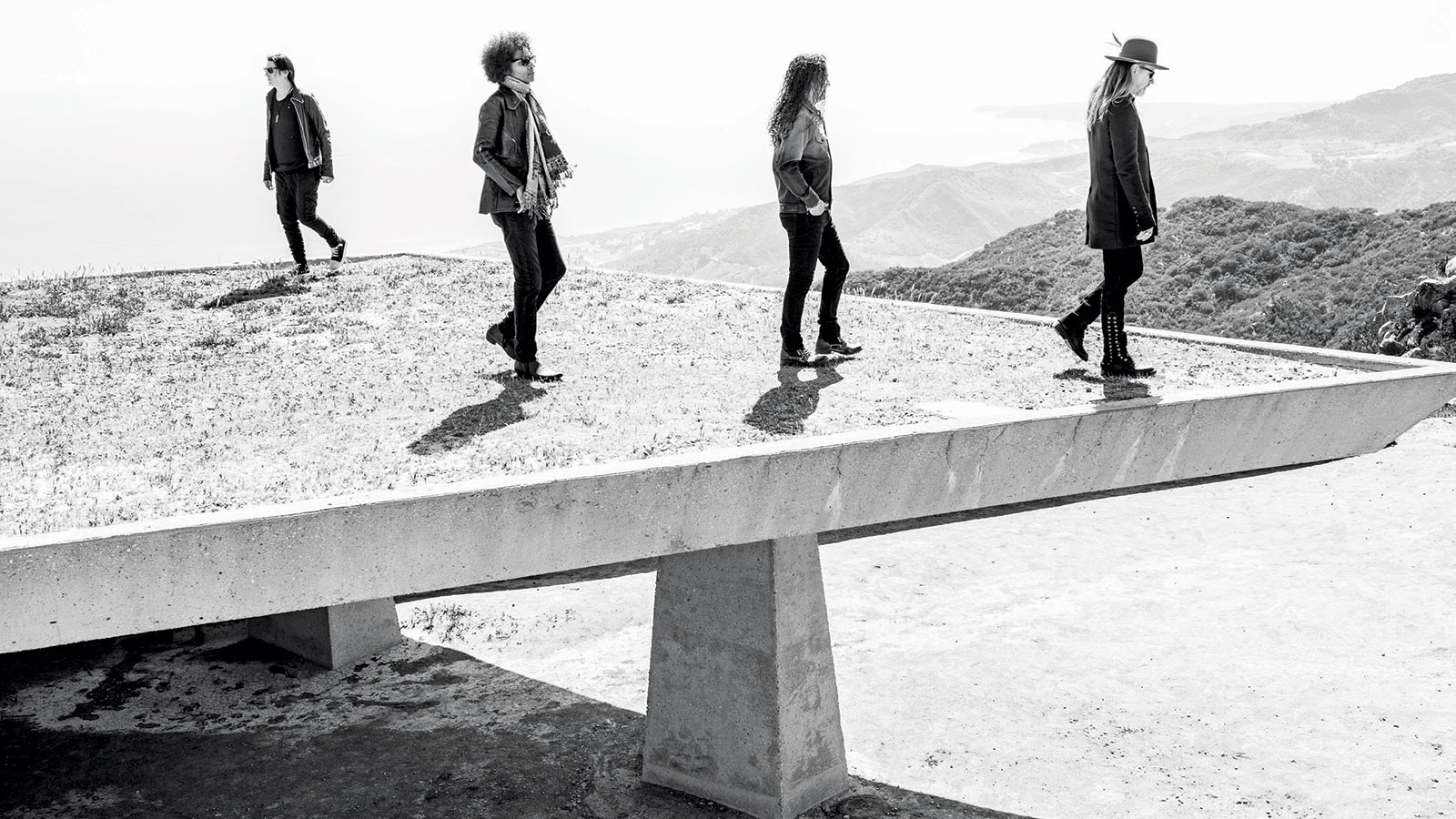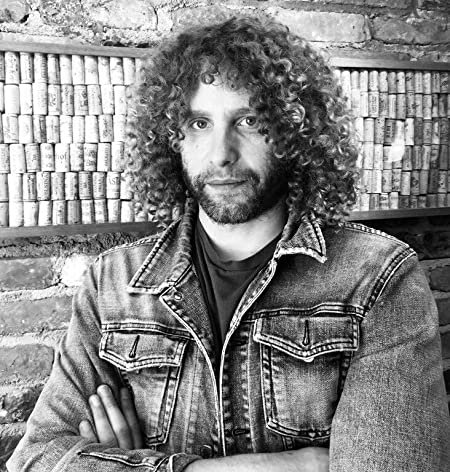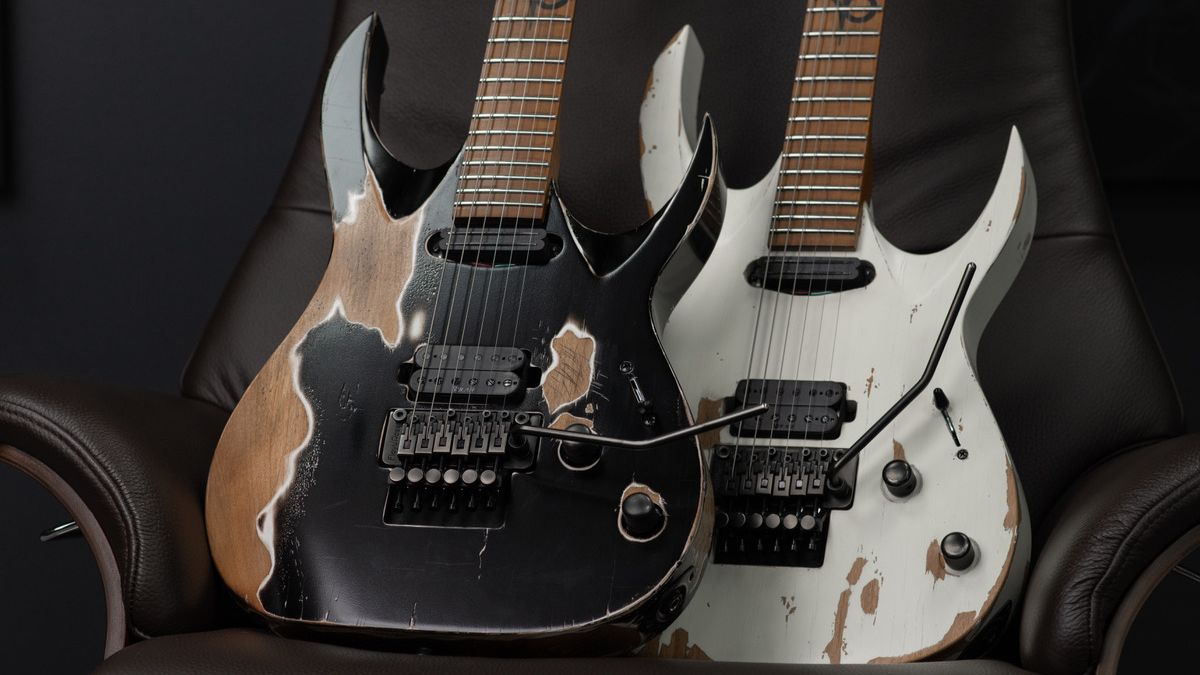Jerry Cantrell Talks New Alice in Chains Album, 'Rainier Fog'
“It’s got our identity all over it, but at the same time, it’s a completely unique record."

It’s been five years since Alice in Chains released their last studio album, 2013’s The Devil Put Dinosaurs Here. Which might seem like a long time, but guitarist, co-vocalist and primary songwriter Jerry Cantrell says it’s really just par for the course for the band these days. “It seems we’re on about a four-or five-year window, and that feels about right,” he says, speaking to Guitar World from his home in Los Angeles. “It takes a couple of years to write and record one, and it takes a couple of years to tour it. Then you go and do it all over again.”
But, he adds, when you do, in fact, do it all over again, “it’s also completely necessary to start from an absolute zero. Because it’s more about making something of quality than just jamming something out every year or two.”
With that, Cantrell launches into talking about Rainier Fog, Alice in Chains’ newest studio album and sixth full-length offering overall. Recorded in five different locales — including, in large part, Seattle’s Studio X, which (back when it was known as Bad Animals) was where Alice in Chains tracked their 1995 self-titled album — the new effort is indeed, to use Cantrell’s own words, something of quality. From the stomping rhythms and dissonant chord stabs of leadoff track and first single “The One You Know”; the buoyant melodies of “Rainier Fog” and the wispy, layered acoustic and electric guitar of “Fly” to the dark, psychedelic swirl of “Maybe”; the soaring, anthemic rock of “Never Fade” and the churning doom-blues of closer “All I Am”; Rainier Fog showcases the various sides and shades of the Alice in Chains sound. And it’s all held together by the band’s now-trademark lush vocal harmonies and Cantrell’s distinctive guitar playing, which is characterized by thick, grinding riffs, wide note bends (for just one example, see the harrowing “So Far Under”) and moaning, languid lead work.
“It’s got our identity all over it,” the 52-year-old guitarist acknowledges about Rainier Fog. “But at the same time, it’s a completely unique record. And we’re really proud of the material we wrote and the performances we captured. There’s some really great shit on it, you know?”
In fact, since reforming in the mid-2000s after roughly a decade of inactivity (a period of time which saw the tragic passing of original singer Layne Staley), Alice in Chains — Cantrell, drummer Sean Kinney, bassist Mike Inez and co-singer and guitarist William DuVall — have done a lot of really great shit, releasing two well-received albums (2009’s Grammy-nominated Black Gives Way to Blue and the follow- up The Devil Put Dinosaurs Here) and embarking on multiple successful world tours. And while they probably could have comfortably done the latter without the former — playing to large crowds in sheds and on festival grounds year after year with a setlist consisting solely of hits from their commercial peak in the 1990s — the fact is that, almost 30 years since the release of their seminal 1990 debut, Facelift, Alice in Chains are still wholly committed to writing and recording new music.
“That’s always been the case with us,” Cantrell says. “Maybe there are a handful of artists that have had a great career and have 20 fucking hits and don’t want to make new music. But most of the musicians I know, they always want to make new stuff. And you know, we’ve only got two EPs and, now, six studio albums. That’s not a lot of records over 30 years. But we’re still making great music and doing it for the same reasons we always did. And if you do that, when you’re lucky, you’ll have an audience that will follow you wherever that road takes you.”
For Rainier Fog you went back to Studio X in Seattle, which has a lot of history for Alice in Chains.
All the latest guitar news, interviews, lessons, reviews, deals and more, direct to your inbox!
Yeah, it was Heart’s studio, Bad Animals, at the time we used it [to record 1995’s Alice in Chains]. And you know, it’s basically the same as it was. These days, a lot of recording stuff is getting kind of left to the wayside because people just record on their fucking computers at home. So a real analog studio with all the cool gear — that doesn’t get used that much. Studio X, they basically use it for orchestras and video games and movie soundtrack-type stuff now. There’s not a whole lot of rock bands there anymore. And you can see that in pretty much any studio you go into nowadays. You walk into Henson [Recording Studios in L.A.] and the hallway is just lined with Studer tape machines that are useless now because nobody records with them. So when we rolled into Studio X, that place hadn’t really been rocked out in a while. And we like to fuck around with everything that’s in there. We actually had to shut down for a couple days and have them go through the board and get everything tuned up.

What was it like to be back there?
It’s a cool room. It’s the hometown room. The bulk of the album was recorded there, and then the next biggest chunk was in Nashville, in [producer] Nick [Raskulinecz]’s studio. Then I did a bunch of vocals and guitar here at my place, and then we finished it off at Henson. And we actually recorded a couple things at [mixer] Joe Barresi’s place during the mix as well — we added that little “Rocket Man” kind of steel guitar slide on “Deaf Ears Blind Eyes.” So technically the album was recorded in five different locations. But the bulk of it was in Seattle and Nashville.
Was there any particular magic that was conjured from being back in Studio X?
Well, you know, aesthetically speaking, yes, because it’s nice being home. Sean [Kinney] lives there, and I’m a part-time resident now. I split my time between Seattle and L.A., though I’m probably in L.A. more. I’ve turned into a lizard — I just wanna roll out of bed and lay on a hot rock and fall in the pool when I wake up. [laughs] Not so easy to do that in Seattle.
So it was a choice that we made. But it wasn’t some big, like, “Hey, we’ve gotta go home and find our roots and connect with the magic!” It wasn’t any shit like that. It was more, “Hey, you wanna record at home?” Okay, cool. “Studio X available?” Okay, cool. Done. It wasn’t any sort of mission to capture something we had lost. We’re good wherever we work. But Studio X is part of our story. It’s where we recorded the self-titled record. And it’s the last studio record we did with Layne, so I guess there’s some significance there, too. It’s not something we spend a whole lot of time thinking about. But it’s all in there. You know the album title, right?
That was going to be my next question: The title references the highest mountain in Washington state, Mount Rainier. Any reason for that?
It just seemed right. Just by circumstances of us making that choice [to record in Seattle]. That song is kind of an homage to the hometown and all of the folks in the area, and our lives and our careers. It felt like an apt title. And it’s a great song.
Let’s talk about some of the songs on the record. The first one I wanted to ask you about is the opening track, “The One You Know,” which is also the first single. The main riff is so abrasive.
It’s a bizarre, dissonant, stabbing riff. It reminds me of the music when Janet Leigh’s getting stabbed in the shower [in the movie Psycho]. Like whee whee whee! [laughs] It always makes me think of that.
That riff is very much in your style, but the guitar tone itself is a little outside of what we think of as your characteristic sound.
Yeah. Tonally, it’s a little more bright. I remember, when we were going through the mix process, we monkeyed with that riff a little bit to make it just a little bit more metallic-sounding. A little more cutting. It’s got an edge to it. It draws blood.
You’ve also said that “The One You Know” has a David Bowie influence. Which, admittedly, is a bit difficult to detect.
[laughs] I almost wish I’d never mentioned that. Because now that I did I have to talk about it! It’s not really an overt influence. But when I listen to music and it starts to become something, then I start making connections in my head to other music. And the connection I made [with “The One You Know”] was to “Fame.” I actually don’t think it sounds like “Fame” at all, but it did remind me of it in the sense of having that kind of spacey, powerful, dick-swagger kind of shuffle with a fucked-up guitar riff. And then in the verse it’s got that weird little creepy riff that is kind of reminiscent of “Fame.” But I didn’t sit down and intend to do that—it’s just a connection I made after the fact. Bowie had passed not long before I wrote the song, so maybe he was just floating around in there a little bit as far as the particular feel. But it doesn’t sound anything like that song. And really, I could go through the whole record and say, you know, “That’s a Jethro Tull moment.” “That’s AC/DC.” “That’s Ted Nugent.” “That’s Eddie Money.” There’s an Eddie Money moment on this record! But 90 percent of these moments no one would ever pick up on. I just know them in my head.
Wait a minute—there’s an Eddie Money moment on the album?
It’s in “Rainier Fog,” actually. There’s that guitar swell as it goes back into the third verse: wheeeern! It reminds me of “Shakin’” [laughs] I remember telling that to the guys in the studio. But these are after-the-fact things. Something reminds me of “Fame” and something else reminds me of “Locomotive Breath” and something else reminds me of “Stranglehold.” And you know, it’s okay to have your influences come through. Especially if you’ve already got your own voice. That shit’s gonna come through—it’s a natural part of the process. But you’re still gonna sound like you. So it’s cool making those connections.
Okay, I’ll throw out a connection I made in my head while I was listening to the album, and you tell me if you agree. Your solo in the song “Fly” — it has this very Southern, classic rock-style phrasing to it. To me, it’s very Skynyrd-ish.
Yup! That’s a good call. That ending riff [sings the last lick], that’s totally Skynyrd, for sure. So there you go.
When it comes to your solos, my sense of things is that you’re a guy who improvises your lines.
You’re wrong! [ laughs] I’m actually much more of a writer than I am a free-form-solo kind of guy. I will do some of that stuff for sure — for feel and for vibe and whatever. But I’m a songwriter, so I write solos, too. That’s probably for two reasons — one, technically I’m not that fucking proficient. I couldn’t tell you what notes I’m playing or what scale I’m using. I can’t tell you that. I just kind of fumble around until I find it. So that’s one part of it. And then the other part is I’ve always looked at a solo as a piece of the music that needs to sing, you know? I always look at it as a cross between a horn line and a vocal line, and stuff like that. So, more often than not, my solos are pretty constructed. But that said, the way I construct them is by doing a lot of improv shit. So, I guess I write solos the same way I write songs. I throw a ton of shit up against the wall, and then I pick out the best pieces and string them together. The early phases of solo writing are impromptu, and then I use what makes sense to me for it to be a really powerful and complete statement in itself. It’s got to be something that’s going to add to the song, and not just a bunch of wankery.

What about your vocals? Are the harmonies that you construct intuitive, or are you thinking in terms of intervals, majors and minors, and things like that?
It’s all by feel. Generally, the way I go about songwriting is that the riff is always first — that’s where it starts. You get enough riffs and you put them all together, and you have a body that sounds like it could be a cool song. Then you start humming melody lines over it, and then the lyrics pretty much come last. Once all of that’s constructed, I just sit and fuck around with harmonies and stuff — I just sing along. But again, I’m not well-versed enough to be able to tell you intervals or keys. I don’t know any of that shit!
This is the third studio album you’ve done with William as a co-singer and guitarist. How has your working relationship developed over that time?
We’ve settled into a thing that works. Vocally it takes both of us to fly the plane, so it’s just about which guy’s voice sounds better on something. If it’s in a range that’s difficult for me, William can cover it, and if it’s in a range that’s difficult for Will, I can cover it. Then some things are constructed for us to kind of meld into one. And others — on the new album, songs like “Rainier Fog,” “All I Am,” “Maybe” — we just kind of feel it out and work out whatever the fuck works. [laughs] So we have a way that we go about doing things. But it does take work. It’s a lot of repetition and sitting there and working it out.
There’s also a third guitarist on the record. Chris DeGarmo, who used to be in Queensryche, makes an appearance.
Yeah! He played on “Drone” — he did the acoustic part that comes before the solo. That picking guitar in the middle, that’s Chris. And then I’m doing the electric on top of him. He lives in Seattle and he came down to the studio a couple of times. I was talking to him one day and I was like, “I’d love to have you on this record somewhere.” And he said, “That’s fine, but I don’t really need to do that. You guys do your thing.” But I was like, “No, I’d really like to have you on it!” So, he agreed, and he came down one day and I just happened to be working on “Drone.” I hadn’t really planned on a part in the song for him, but that was the day he showed up. And the part I was playing has this sort of fucked-up spider chord in it — where your pinkie is kind of dominant in the middle of the fretboard… it’s difficult, especially on an acoustic — and if you wanna take that a step further, it’s even more difficult on a 12-string. It’s nearly impossible to do without fretting out, or buzzing or whatever.
Well, back in the day Queensryche was known for using those sorts of extended chord voicings. That was Chris DeGarmo’s thing.
Exactly. He was totally the guy to do that. So when it was time to record that part I was kind of fumbling around with it, and I was like, “Why don’t you try it?” [laughs] And he said okay. So the way we did it — and we did this on a few songs — was that instead of doing one 12-string pass we did two six-string passes. One take with a guitar with super-thin strings, and then one take with a regular acoustic. Then you get the 12-string effect by running them together. Chris did two passes, and he did a great job. And more importantly, he’s one of my friends and one of my heroes from my hometown. I fucking love Queensryche. So it was great to have him on the record.

What gear did you use on Rainier Fog?
It’s pretty much the same stuff we always use. A good dose of G&L guitars. A lot of Gibson Les Paul. We’ll use some different guitars here and there for different vibes. Some Tele. Some Strat. I think we always end up whipping out Nick’s Flying V and using that for like a break/middle sound. And my buddy Mike Tempesta [formerly of Powerman 5000] got me one of those Gretsch Malcolm Young tribute replicas — I used that on “Maybe” and I think on “Fly” and one or two other songs. That guitar has a great fucking tone. And then there were various acoustics —Gibsons, Gretsches and Martins.
Ampwise, I used a lot of my Friedman Double J model [the Friedman JJ-100 Jerry Cantrell] and some Bogner — we always use a bunch of that. Nick also has a Laney Klipp and an Orange head that we used quite a bit. I think we used a [Vox] AC30 on some of the cleaner, janglier stuff. Another thing that was cool—you know that super-heavy part on “Drone”? That dah dah dah da-dahhh… Nick went down to the Pike Place Market in Seattle and bought this little amp that was made out of a cigar box for, like, 150 bucks or something like that. We used that amp on a couple of songs and it sounded so fucking great. I mean, it sounded like dogshit on its own. [laughs] But when we recorded it and laid it over the other stuff, it just amplified everything in the most gnarly way. It’s the kind of thing where if you have it in there it’s not necessarily something you notice, but when you take it away it’s something you completely notice. Like, “What just happened? The balls just went away!”
Earlier you mentioned how recording studios aren’t used by bands the way they once were. What do you think about the changes the industry has undergone over the past decade or so?
Well, things like Pro Tools — all the computer software, the editing stuff — you can do things quicker than you used to. So those are all good things. But, if you live in that world all the time, I think you lose some of the weight and depth and richness of the analog way of recording. We’ve always tried to do an equal mix of both and be in this place where you’re not completely moving into MP3-land, but you’re trying to use the benefits of the technology of today. And you’re also trying to not throw away what’s really cool about recording on tape, and going through a Neve board, and using analog gear and effects and cool microphones. It’s great using the technology we have today — it makes things easier, and in some cases it makes things a little cheaper. But you don’t want to lose those elements that add quality. I think a blend of both is good.
Do you think it’s more difficult to be a rock band these days?
Well, I don’t ever recall it being easy, you know? [laughs] So it’s just different now. As time goes on and as different generations of music come and go, the industry itself goes through changes. Technology advances and there are just natural things you have to adapt to. You always have to adapt to something.
Rock music has gone through a few permutations since we first had our day in the fucking sun, you know? Then it’s on to the next thing. And that’s totally okay. Shit, things change. That’s just part of fucking life.
•GUITARS G&L Rampage (vintage and Jerry Cantrell Signature models), G&L Superhawk Deluxe Jerry Cantrell Signature, Gibson Les Paul Custom, Gretsch G6131MY-CS Custom Shop Malcolm Young “Salute” Jet, Gibson SG, Fender Custom Shop Stratocaster, Fender Telecaster, Gibson Flying V, plus Martin, Guild and Gibson acoustics
•AMPS: Friedman JJ-100 Jerry Cantrell Signature; vintage Marshall 2550 Silver Jubilee; vintage Orange; Bogner Fish; Soldano SLO- 100; Laney Klipp; Vox AC30; cigar box amp
•PEDALS: Dunlop JC95 Jerry Cantrell Signature Cry Baby Wah; Ibanez TS808 and TS9 Tube Screamer; Dunlop Talk Box; Electro-Harmonix Electric Mistress; Electro- Harmonix Memory Man; Dunlop JH-OC1 Jimi Hendrix Octavio; F’Lon (Klon Centaur clone built by engineer Paul “Fig” Figueroa)
Rich is the co-author of the best-selling Nöthin' But a Good Time: The Uncensored History of the '80s Hard Rock Explosion. He is also a recording and performing musician, and a former editor of Guitar World magazine and executive editor of Guitar Aficionado magazine. He has authored several additional books, among them Kurt Cobain: Montage of Heck, the companion to the documentary of the same name.

